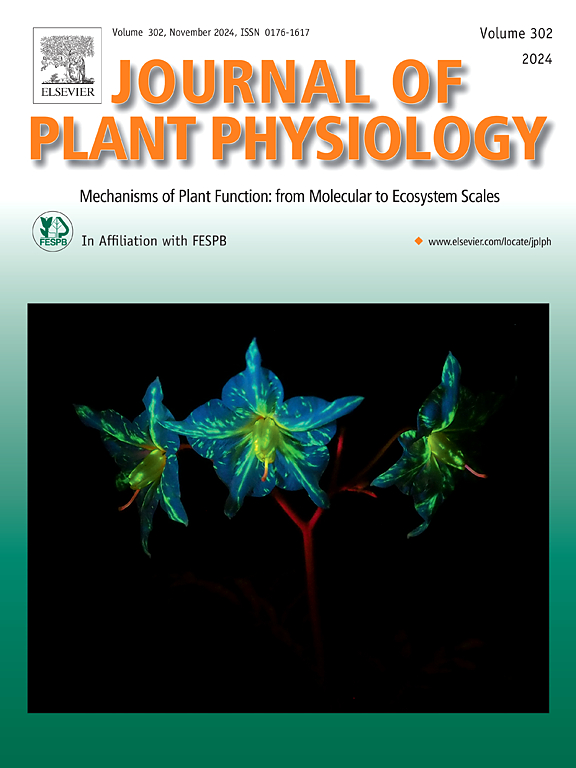WEE1 homolog positively regulates salt stress tolerance in chrysanthemum
IF 4.1
3区 生物学
Q1 PLANT SCIENCES
引用次数: 0
Abstract
Salinity is a major abiotic stress that limits chrysanthemum yields worldwide. Salinity represses Chrysanthemum lavandulifolium plant growth and consequently reduces chrysanthemum commercial production. Salinity triggers DNA damage in root cells, leading to cell death and subsequent growth repression. WEE1 plays an important role in regulating DNA repair, although its function in salt tolerance has not been studied in C. lavandulifolium. In this study, we identify WEE1 homologous genes in Chrysanthemum species, and their expressions are induced in roots after salt stress treatment. We further investigate the function of C. lavandulifolium homolog ClWEE1 in salt stress responses and find that ClWEE1 plays a crucial role in cell cycle regulation and DNA damage repair under salt stress. Overexpressing ClWEE1 in C. lavandulifolium or Arabidopsis significantly enhances their salt stress tolerance. Both flow cytometric analysis and comet assay reveal less DNA damage in ClWEE1-overexpression plants than in wild type. RT-qPCR analysis indicates that the stress-responsive genes ClNHX, ClHKT, ClCBL, and ClDREB2A may have higher expression in ClWEE1-overexpression plants than in wild type. Taken together, our study illustrates the positive role of Chrysanthemum WEE1 in enhancing salt tolerance, providing insights for breeding salt-tolerant chrysanthemum varieties.
WEE1同源物正调控菊花耐盐性
盐度是限制世界范围内菊花产量的主要非生物胁迫。盐度抑制了菊花的生长,从而减少了菊花的商业生产。盐度触发根细胞的DNA损伤,导致细胞死亡和随后的生长抑制。WEE1在调节DNA修复中发挥重要作用,但其在薰衣草耐盐性中的功能尚未被研究。本研究在菊花中鉴定出WEE1同源基因,并在盐胁迫下诱导其在根中表达。我们进一步研究了薰衣草同源基因ClWEE1在盐胁迫响应中的功能,发现ClWEE1在盐胁迫下的细胞周期调控和DNA损伤修复中起着至关重要的作用。过表达ClWEE1能显著提高薰衣草和拟南芥的耐盐性。流式细胞分析和彗星分析显示,clwee1过表达植物的DNA损伤程度低于野生型。RT-qPCR分析表明,胁迫应答基因ClNHX、ClHKT、ClCBL和ClDREB2A在过表达clwee1的植物中表达量可能高于野生型。综上所述,本研究说明了WEE1在提高菊花耐盐性方面的积极作用,为选育耐盐菊花品种提供了参考。
本文章由计算机程序翻译,如有差异,请以英文原文为准。
求助全文
约1分钟内获得全文
求助全文
来源期刊

Journal of plant physiology
生物-植物科学
CiteScore
7.20
自引率
4.70%
发文量
196
审稿时长
32 days
期刊介绍:
The Journal of Plant Physiology is a broad-spectrum journal that welcomes high-quality submissions in all major areas of plant physiology, including plant biochemistry, functional biotechnology, computational and synthetic plant biology, growth and development, photosynthesis and respiration, transport and translocation, plant-microbe interactions, biotic and abiotic stress. Studies are welcome at all levels of integration ranging from molecules and cells to organisms and their environments and are expected to use state-of-the-art methodologies. Pure gene expression studies are not within the focus of our journal. To be considered for publication, papers must significantly contribute to the mechanistic understanding of physiological processes, and not be merely descriptive, or confirmatory of previous results. We encourage the submission of papers that explore the physiology of non-model as well as accepted model species and those that bridge basic and applied research. For instance, studies on agricultural plants that show new physiological mechanisms to improve agricultural efficiency are welcome. Studies performed under uncontrolled situations (e.g. field conditions) not providing mechanistic insight will not be considered for publication.
The Journal of Plant Physiology publishes several types of articles: Original Research Articles, Reviews, Perspectives Articles, and Short Communications. Reviews and Perspectives will be solicited by the Editors; unsolicited reviews are also welcome but only from authors with a strong track record in the field of the review. Original research papers comprise the majority of published contributions.
 求助内容:
求助内容: 应助结果提醒方式:
应助结果提醒方式:


